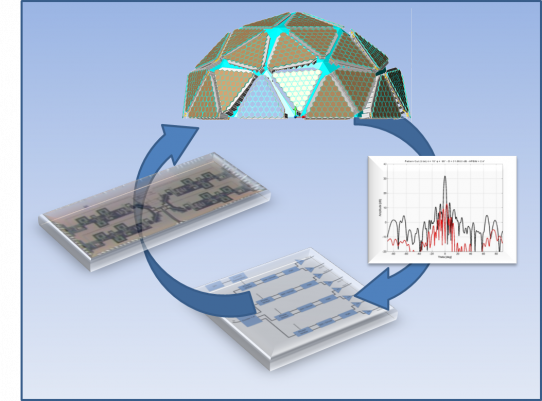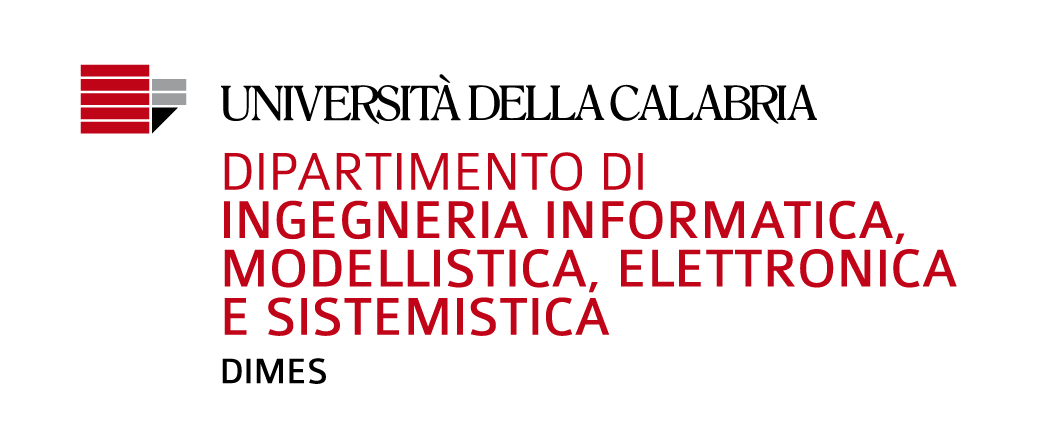
-
StatusCompleted
-
Status date2018-12-03
-
Activity Code7C.026
The proposed antennas have been designed and optimized by benefitting from the concept of MMIC multinode.
The proposed antennas work separately in Rx and Tx frequency bands, a modular architecture for the a conformal antenna (dome shape) have been proposed and analyzed in detail. Both the Antennas are composed by means of 40 tiles, which only 16 of them are on in the same time.
The Tx antenna is composed by 1280 radiating elements and 320 Tx SiGe MMICs. The Rx Antenna is composed by 4800 radiating elements and 1200 Rx SiGe MMICs.
The MMIC development has been done by the project team using the SiGe European foundry process of IHP (part of the team): SG25H3.
The two developed multi-node MMICs (Tx and Rx) and the PA can be considered state of the art with regard to the complexity of the functions implemented both at the RF and digital levels.
The developed MMICs incorporate many functional blocks: RF (active and passive), digital interface (SPI), biasing and current sources used for the implementation of the phase shifter.

The main challenge of the Project is to design and integrate Ka band SiGe MMICs for a low profile antennas, using a European foundry.
The integration of the MMICs (both Sige and GaAs) in representative antenna demonstrators was the most complex activity.
Also the tuning of the MMICs design with the manufactured MMIC build block, required notable effort in terms of manpower and use SW tools.
The use of the developed MMICs allows the development of "Phased Array" mobile terminals with enhanced capability of beam steering; greatly reducing the number of components compared to a traditional GaAs technology. In fact, GaAs does not allow a reduction in the number of control commands as possible with the use of MMICs in SiGe. Even if the E / D technology, which allows the integration of digital circuits in the GaAs MMICs, is able to work up to Ku-band frequency, the process is very expensive and requires a large area of MMIC for digital parts.
The two developed multi-node MMICs (Tx and Rx) and the PA can be considered state of the art with regard to the complexity of the functions implemented both at the RF and digital levels.
It should be noted that the PA has been developed separately from the MMIC multinode Tx, to allow the correct evaluation of performance. However, the PA is perfectly compatible in terms of size and power supply with the MMX Tx and its channels. In fact, a future version could easily integrate the Tx MMIC and PAs together on the same chip.
The developed MMICs incorporate many functional blocks: RF (active and passive), digital interface (SPI), biasing and current sources used for the implementation of the phase shifter.
The proposed antennas work separately in Rx and Tx frequency bands, a modular architecture for the conformal antenna (dome shape) have been proposed and analysed in detail. Both the Antennas are composed by means of 40 tiles, which only 16 of them are on in the same time.
The Tx antenna is composed by 1280 radiating elements and 320 Tx SiGe MMICs. The Rx Antenna is composed by 4800 radiating elements and 1200 Rx SiGe MMICs.
|
Reviews |
Event |
|
KO |
Negotiation/Kickoff |
|
PACS |
Preferred Antenna Concept Selection |
|
APDR |
Antenna Preliminary Design Review |
|
DDR |
BFN/RF Front end Detailed Design Review |
|
BB-TR |
Building Blocks Test Review |
|
MMIC-TR |
MMIC Test review |
|
DTR |
Demonstrator Test Review |
|
FP |
Final Presentation |
The Project has been completed.
The MMICs demonstrate good performance in terms of phase granularity and, based on the measurements made, statistical errors have been estimated. These errors are sufficiently limited and homogeneous on all MMIC channels.
Finally, the SKATE program has allowed the acquisition of preparatory knowledge for the development of MMIC in SiGe with European foundry technology that can be used in mainly aircraft-based mobile terminals. The developed MMICs are the basis for the development of low profile, fully electronic, conformal antennas.






